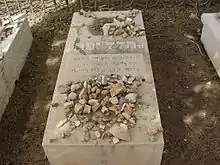Visitation stones
The act of placing visitation stones is significant in Jewish bereavenment practices. Small stones are placed by people who visit Jewish graves in an act of remembrance or respect for the deceased. The practice is a way participating in the mitzvah of burial. The stone is placed by the left hand.[1]

Marking a grave with stones was customary in Biblical times before the adoption of gravestones.[2][1] The oldest graves in the Old Cemetery in Safed are piles of rocks with a more prominent rock bearing an inscription.[1]
It is not customary in Judaism to leave flowers at a grave after visiting. It is believed to be more appropriate to give money to charity that could otherwise be spent on flowers.[3]
Formerly the tradition might have been to insert notes into crevices in the grave marker. This tradition may be related to the practice of placing notes in the Western Wall in Jerusalem. Letters may have been formerly written to the deceased and held down by a stone, the stone would have been left after the paper blew away.[3]
The tradition has also been noted outside of Jewish mourning practices; Robert McFarlane notes the presence of stones placed by mourners in the alcoves of the recesses of resting stones in ancient Ireland.[2]
Interpretation
Various explanations have been given for the origin of the practice[1]
- Stone is frequently used in the torah as a metaphor for God in Judaism
- To ensure that kohanim should not be affected by corpse impurity by inadvertently coming into close proximity with a grave
- To ensure that the mitzvah is maintained by marking the grave with rocks
References
- "Placing a Stone". Shiva.com. Retrieved 22 April 2020.
- Julie Bates (19 April 2017). Beckett's Art of Salvage. Cambridge University Press. p. 215. ISBN 978-1-107-16704-9.
- Barbara Binder Kadden; Bruce Kadden (1997). Teaching Jewish Life Cycle: Traditions and Activities. Behrman House, Inc. p. 107. ISBN 978-0-86705-040-0.
| Wikimedia Commons has media related to Category:Pebbles on Jewish gravestones. |
